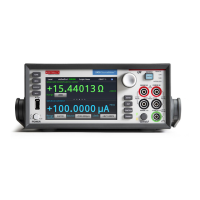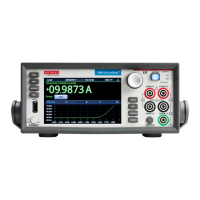Interactive SourceMeter® Instrument Reference Manual Section 2:
2450-901-01 Rev. B/September 2013 2-97
To make a measurement, you send the MEASure:<function>? command. For example, to make a
current measurement, send the command:
:MEASure:CURRent?
To make a voltage measurement, send the command:
:MEASure:VOLTage?
To make a resistance measurement, send the command:
:MEASure:RESistance?
For detailed application examples that use the SCPI command language, see the User's Manual.
Command descriptions are provided in the SCPI command reference (on page 6-1
).
Source and measure using TSP commands
The TSP commands that set up the source functions begin with smu.source.
The source commands are specific to each source function (voltage or current). For example, to set
the range to 100 mA for the current source function, you would send:
smu.source.func = smu.FUNC_DC_CURRENT
smu.source.range = .1
To set the range to 20 V for the voltage function, you would send:
smu.source.func = smu.FUNC_DC_VOLTAGE
smu.source.range = 20
The TSP commands that set up the measurement functions begin with smu.measure.
The sense commands are also specific to each measure function (voltage, current, or resistance). For
example, to set the NPLC cycles to 0.5 for the current measurement function, you would send:
smu.measure.func = smu.FUNC_DC_CURRENT
smu.measure.nplc = .5
For the voltage measurement function, you would send:
smu.source.func = smu.FUNC_DC_VOLTAGE
smu.measure.nplc = .5
For the resistance measurement function, you would send:
smu.source.func = smu.FUNC_RESISTANCE
smu.measure.nplc = .5

